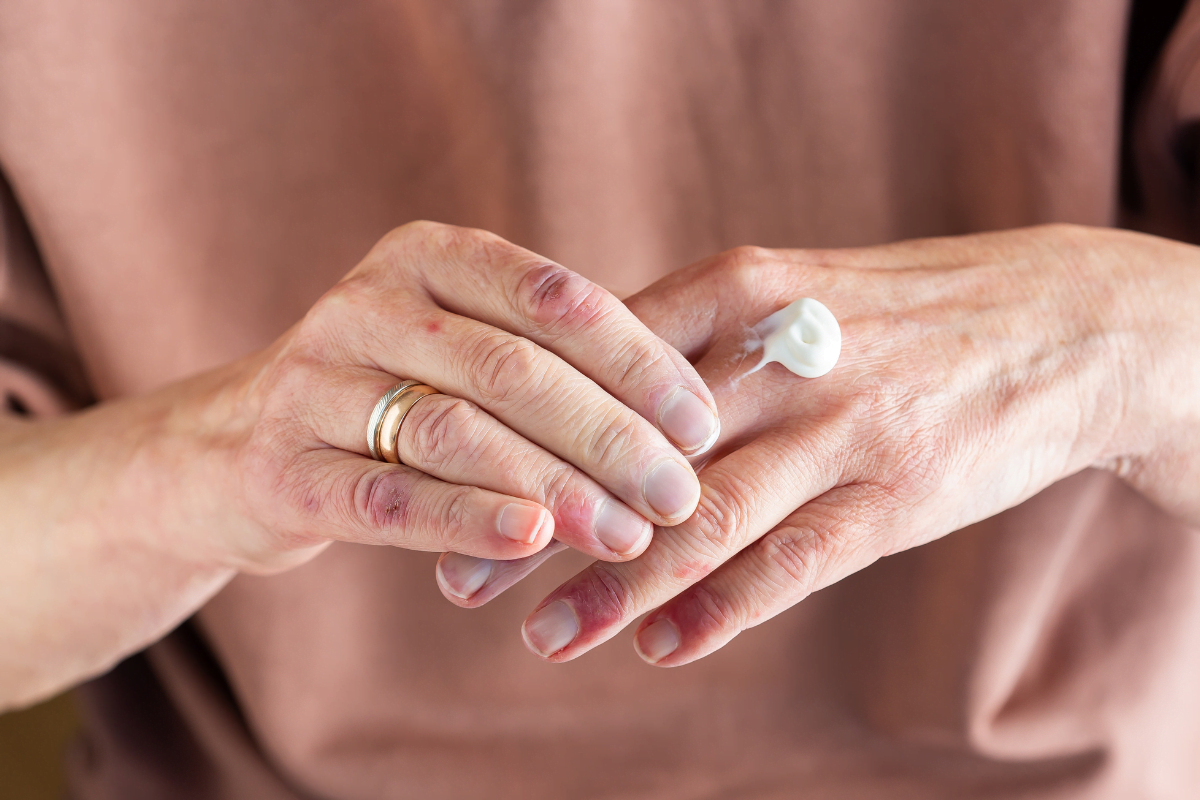Hand and foot rashes can be confusing, painful, and stubborn. Many people want clear, practical ways to tell palmoplantar pustulosis vs dyshidrotic eczema apart and to advocate for the right care. This guide translates clinical features into plain signs you can spot, while staying grounded in evidence. We also highlight tests and treatments you can discuss with your clinician.
Key Takeaways
- Location and look: pustules vs deep blisters help differentiate.
- Smoking links strongly with palmoplantar pustulosis; moisture aggravates pompholyx.
- Patch testing, scraping, or biopsy can clarify difficult cases.
- Topicals, light therapy, and systemic agents are options when needed.
What These Conditions Are
Palmoplantar pustulosis (pustular psoriasis limited to palms and soles) causes cycles of sterile yellow pustules on thick, scaly skin. The surrounding skin often becomes red and cracked, and flares may impair walking or grip. Clinicians consider it within the psoriasis spectrum, though debates continue about how distinct it is from palmoplantar psoriasis.
Dyshidrotic eczema (pompholyx; deep “tapioca” vesicles on hands and feet) presents with clusters of very itchy, small blisters. The skin may later peel and fissure. Flares can follow stress, heat, sweating, metal exposure, or irritant contact. People with atopic tendencies may be more prone to this pattern.
Tip: Track flares with a simple calendar noting triggers like heat, friction, new soaps, or cigarettes. This record helps your clinician spot patterns and adjust care.
Comparing palmoplantar pustulosis vs dyshidrotic eczema
Both conditions target the palms and soles, but their lesions differ. In palmoplantar pustulosis, you typically see clusters of pinhead to pea-sized pustules on a background of thickened, scaly plaques. These pustules are filled with neutrophils, not bacteria, so they are sterile. Pain and cracking can limit daily activities such as standing, lifting, or typing.
In dyshidrotic eczema, tense, very itchy vesicles sit deeper in the skin and feel like beads under the surface. They often flare with sweating or stress and can co-exist with irritant contact dermatitis. Over time, the blisters dry, peel, and may leave tender fissures. Knowing these patterns helps you and your clinician choose tests and treatments wisely.
Triggers and Causes: What Drives Flares
Palmoplantar pustulosis has strong associations with cigarette smoking and, in some people, upper airway infections or metal sensitivity. Genetics and immune dysregulation play roles, similar to other psoriasis forms. When clinicians discuss palmoplantar psoriasis causes, they often include mechanical friction, chronic irritation, and occasional drug triggers as potential contributors.
Dyshidrotic flares may follow heat, occlusion from gloves or boots, stress, or exposure to metals like nickel or cobalt. People with a history of atopic dermatitis may notice seasonal swings. Consider a patch test when flares link to jewelry, occupational chemicals, or personal care products. Reducing wet work and using cotton liners under gloves can lower the burden of moisture and friction.
The American Academy of Dermatology describes hallmark dyshidrotic eczema features, including deep-seated vesicles, which align with the patterns noted above.
How They Look and Feel on Skin
Palmoplantar pustulosis often begins with burning or tenderness, followed by crops of pustules on the thenar/hypothenar pads, insteps, or heel borders. The surrounding stratum corneum thickens and cracks. Nails can show pitting or onycholysis in some patients, reflecting its psoriasis linkage and adding diagnostic clues over time.
Dyshidrotic eczema flares with intense itch before blisters appear on sides of fingers, palms, or soles. The blisters tend to cluster and can coalesce into larger tense areas. If you are comparing rashes visually, guidance like psoriasis vs eczema pictures can help frame conversations, but clinical exam and history remain essential to avoid mislabeling.
Note: Photos guide expectations, but lighting, skin tone, and disease stage can mislead. Use images only as a starting point, not a diagnosis.
Diagnosis and Useful Tests
Diagnosis usually begins with history and exam: timing of flares, itch versus pain, smoking status, sweating, and exposures. Your clinician may perform a potassium hydroxide (KOH) scraping to rule out tinea, since fungal infections can mimic either condition. Bacterial culture is considered when painful fissures or crust suggest secondary infection.
When allergens are suspected, patch testing can uncover metals, fragrances, or preservatives that worsen dyshidrotic patterns. Blood tests are not diagnostic for either condition but may help rule out mimics or monitor systemic therapy. Imaging is rarely needed; instead, targeted skin sampling provides clarity in persistent or atypical cases.
When a Skin Biopsy Helps
In challenging cases, a punch biopsy distinguishes pustules from vesicles and clarifies inflammation patterns. Pathology can show spongiform pustules and neutrophilic collections in palmoplantar pustulosis histology, while dyshidrotic eczema typically reveals spongiotic change with intraepidermal vesicles. This level of detail matters when first-line treatments fail, or when infection or autoimmune blistering disorders remain on the table. Discuss pros and cons of biopsy, including a small scar risk, against the benefit of diagnostic certainty.
For broader context on psoriasis subtypes, the AAD overview of pustular psoriasis offers patient-friendly descriptions that align with biopsy findings and clinical pictures.
Treatment Options: Stepwise and Individualized
Plans start with skin protection and trigger control. Emollients seal moisture; fragrance-free cleansers reduce irritants. Potent topical corticosteroids may calm inflammatory flares on thick palms and soles, often under occlusion. For steroid-sparing care, topical calcineurin inhibitors may help sensitive or thin-skinned areas; for steroid‑sparing details, see Protopic Ointment, which discusses tacrolimus uses and considerations.
When disease is severe or refractory, clinicians may consider phototherapy or systemic options. Some patients explore intralesional steroids for focal plaques; for formulation information and professional guidance context, see Kenalog Injection as one corticosteroid reference. For those specifically seeking palmoplantar pustulosis treatment, plans can include careful occlusion, keratolytics like urea or salicylic acid, and, in selected cases, systemic agents chosen with safety monitoring.
People comparing options across conditions often ask about natural approaches. Evidence for complementary steps is limited, but stress reduction, smoking cessation, gentle skin care, and trigger avoidance may support medical therapy. Discuss supplements or elimination diets with your clinician to avoid interactions; a balanced approach is safer than trial-and-error alone.
NIAMS eczema resources outline standard therapy classes and emphasize moisturization and trigger management, which overlap with hand–foot care strategies.
Living With These Conditions: Prevention and Self-Management
Daily routines matter. Choose thick, fragrance-free moisturizers after every hand wash and before bed. Wear cotton liners beneath work gloves to reduce sweat and friction. Rotate footwear, allow shoes to dry fully, and change socks mid-day if moisture builds. These small steps can reduce flares and protect the skin barrier while treatments work.
Many ask how rare is palmoplantar pustulosis. It is uncommon compared with plaque psoriasis and tends to affect adults, particularly people who smoke. Because it can wax and wane, tracking pain, itch, function, and triggers helps measure progress beyond photos. For dyshidrosis, address overheating and stress where possible, and keep nails short to minimize damage from scratching.
Patients often worry about contagion. Palmoplantar psoriasis contagious risks are not a concern, because psoriasis is not infectious. Similarly, dyshidrotic eczema is not spread person-to-person. Secondary infection can occur from skin breaks, so timely wound care and medical review are important when pain, pus, or fever develops.
Diet, Work, and Lifestyle Factors
While no single diet cures these conditions, some people experiment with a palmoplantar pustulosis diet that reduces smoking, alcohol, and processed foods while emphasizing whole grains, lean proteins, and anti-inflammatory fats. Evidence is limited, but general nutrition goals can support overall health. Hydration and sleep also influence skin repair and stress resilience.
Work exposures matter. Hairdressers, mechanics, health workers, and food handlers frequently encounter irritants and wet work that fuel flares. If you suspect workplace triggers, request a review of safety data sheets and consider patch testing. Simple changes—like switching cleansers, adding glove liners, or rotating tasks—can blunt triggers without disrupting your livelihood.
Red Flags and When to Seek Care
Seek timely evaluation if pain limits walking or using your hands, if you notice rapidly spreading redness, or if fever or drainage develops. These signals may suggest infection or another diagnosis requiring prompt attention. Worsening nail changes, widespread rash, or new medications around the time of flares also warrant review.
Consider referral to dermatology when first-line measures fail after reasonable trials, when diagnosis remains uncertain, or when systemic therapy is on the table. A specialist can help differentiate pustular psoriasis vs dyshidrotic eczema in stubborn cases and tailor testing and therapy to your goals and comorbidities.
Recap
Palm and sole rashes are challenging, but patterns point the way. Pustules on thick skin, smoking history, and nail changes lean toward a psoriasis spectrum disorder. Deep itchy vesicles, sweating triggers, and contact exposures lean toward pompholyx eczema. Use this practical framework to prepare for your visit, ask focused questions, and co-design a plan that fits your life.
Pain relief, barrier repair, and trigger control remain the backbone of care. Add tests when the picture is murky, and escalate treatments thoughtfully when function or quality of life suffers. With patience and a stepwise approach, most people can gain better control and reduce flares over time.
This content is for informational purposes only and is not a substitute for professional medical advice.

